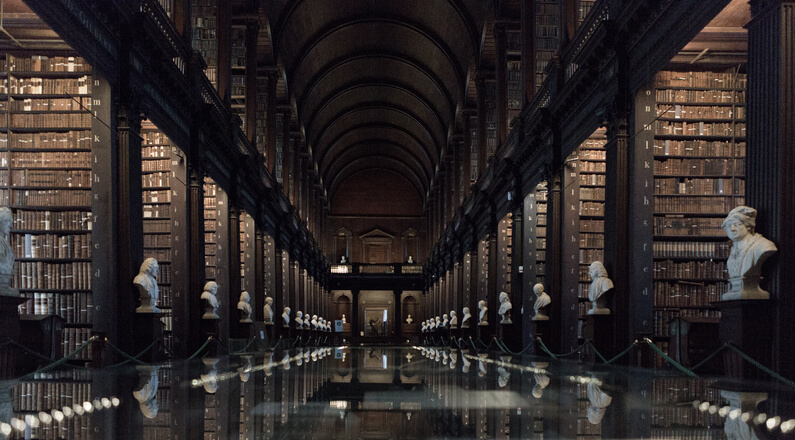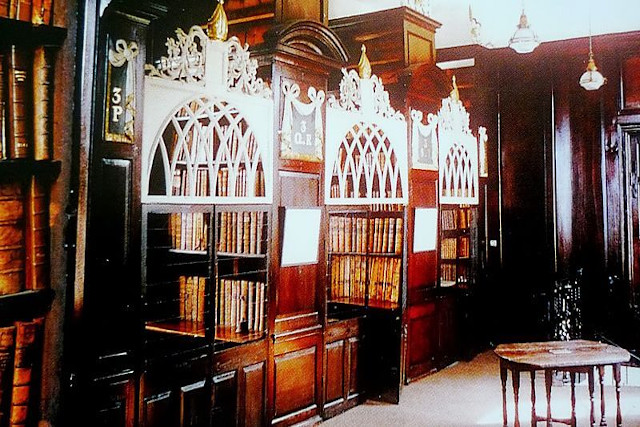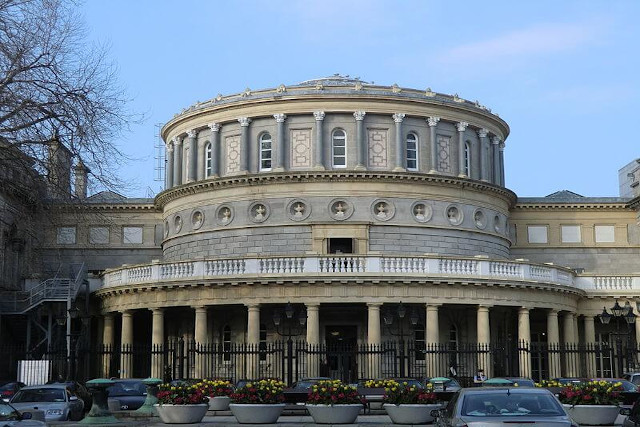These libraries are a bibliophiles delight! These beautiful buildings have fascinating histories and house vast collections of books, some of them extremely rare. Read on to discover the stories of these famous libraries in Ireland.
Trinity College Library, Dublin

Founded in 1592, Trinity College is the oldest university in Ireland. Its library is home to thousands and thousands of books, a collection that is growing all the time – it is a legal deposit for publishers in Ireland and also for works published in the United Kingdom. The library occupies several buildings on the campus but the most famous building, and oldest, is known as the Old Library. It houses the Book of Kells, a 9th century illuminated gospel manuscript and the Brian Boru harp, one of three surviving medieval Gaeliic harps. The Long Room, a 65 metre long vaulted main chamber, holds around 200,000 of the rarest books and is a beautiful piece of design and construction. Standing at one end of the chamber, the rows appear to continue on and on indefinitely.
Linen Hall Library, Belfast
Founded in 1788 by a group of artisans, Linen Hall Library is the oldest library in Belfast. Originally without fixed premises, the library took up permanent residence in 1802 in White Linen Hall, where it remained for almost 100 years before moving to a new location in 2000. The library is renowned for its Northern Ireland Political Collection – over 350,000 items including posters, manifestos and books relating to the Troubles. The collection consists of material from all sides and political groups of the conflict, making it somewhat of a definite archive. Other notable works include a vast Irish and Local Studies collection and the largest collection of work relating to Robert Burns held outside of Scotland.
Marsh’s Library, Dublin

The oldest public library in Ireland, Marsh’s Library was founded in 1707 by Archbishop Narcissus Marsh and contains over 25,000 books. The bulk of the library consists of four collections of books from Archbishop Marsh, Edward Stillingfleet, Elie Bouhéreau and John Stearne. The subjects of the books vary from theology and religion, medicine, navigation and music. The library still contains original bookcases and seats, as well as three wire cages that readers were locked inside whilst reading, in order to prevent books being stolen.
Notable works on display include early editions of Dante’s Divine Comedy and Isaac Newton’s Principia Mathematica, as well as an exhibit of the extremely rare books – the only copies that exist are the ones in Marsh’s Library!
Rathmines Library, Dublin
Rathmines Library is one of a number of libraries built across Ireland that was financed by Andrew Carnegie, founder of the Carnegie Company, a steel-producing company in America. After selling the company to J.P.Morgan in 1901, in what was one of the biggest business sales of that time, Carnegie pursued a philanthropic career. By the end of his life he had given away $350 million and a significant portion of this was used to finance the establishment of public libraries – almost 3,000 in total. In Ireland, roughly 80 libraries were built with contributions from Carnegie and his trusts. Built in 1913, with a grant of £8,500, Rathmines Library was the first public access library in Ireland. It is a beautiful example of neo-Georgian design and it still retains many original features today.
National Library of Ireland, Dublin

This magnificent Victorian building was designed by Thomas Newenham Deane and one of the most striking elements is the domed Reading Room – lined with shelves of books and almost 50 feet high in the centre. Established in 1877, the National Library of Ireland holds the most comprehensive collection of Irish documents anywhere in the world. This collection consists of documentation in a number of formats including printed material, manuscripts, photographs, drawings and digital works. Notable works include personal notes and notebooks belonging to Seamus Heaney, James Joyce and W.B.Yeats.
The National Library is a reference library, meaning that any visitors are unable to borrow books, but can consult material without charge. The library also has a genealogy service and thousands of people visit every year in order to conduct research into their ancestry and lineage.
Armagh Robinson Library, Armagh
The oldest public library in Northern Ireland, the Armagh Robinson Library was founded in 1771 by Archbishop Robinson. He donated his vast collection of 17th and 18th century books covering topics such as philosophy, history, medicine and law. Today the number of books in its collection stands at around 42,000 and includes a rare first edition of Jonathan Swift’s Gulliver’s Travels, complete with author notations, Sir Walter Raleigh’s 1614 History of the World and the Silver Maces, presented to Armagh when it became a city in 1656.
Image credit: Tim Tregenza – (CC-BY-SA 3.0); YvonneM – (CC-BY-SA 3.0)